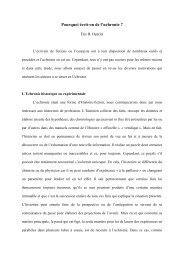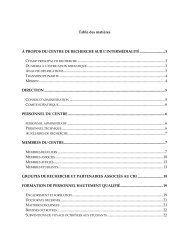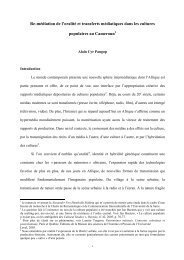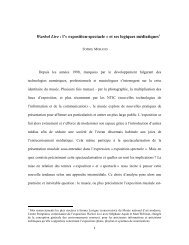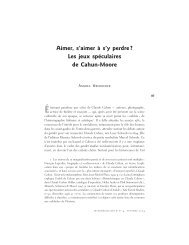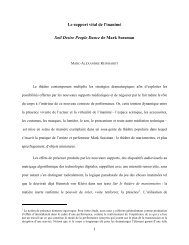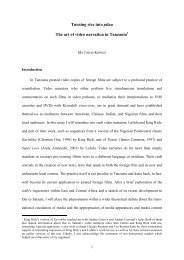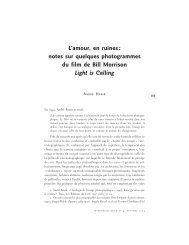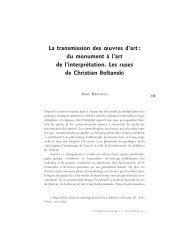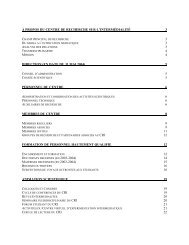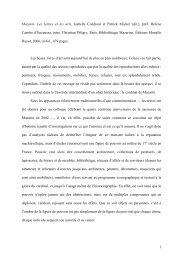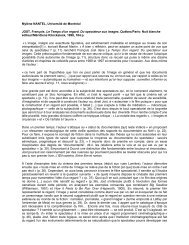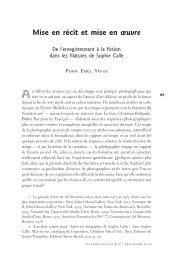Intermediality - Centre de recherche sur l'intermédialité (CRI ...
Intermediality - Centre de recherche sur l'intermédialité (CRI ...
Intermediality - Centre de recherche sur l'intermédialité (CRI ...
Create successful ePaper yourself
Turn your PDF publications into a flip-book with our unique Google optimized e-Paper software.
44<br />
intermediality, intertextuality, and remediation<br />
Taking into account the long tradition of interarts studies, it becomes apparent<br />
that much of what is generally treated un<strong>de</strong>r the heading of intermediality is in no<br />
way a novelty. While it is true that some new aspects and problems have emerged,<br />
especially with respect to electronic and digital media, intermedial relations and<br />
processes per se remain phenomena which have been recognized for a long time.<br />
This fact is easily overlooked on account of those approaches to intermediality<br />
that concentrate specifi cally on so-called New Media; traditional interarts studies,<br />
however, have in their own way consistently acknowledged it. The sustained<br />
success and growing international recognition of the concept of intermediality,<br />
therefore, point less to new types of problems per se than (at least potentially)<br />
to new ways of solving problems, new possibilities for presenting and thinking<br />
about them, and to new, or at least to different views on medial bor<strong>de</strong>r-crossings<br />
and hybridization; in particular, they point to a heightened awareness of the<br />
materiality and mediality of artistic practices and of cultural practices in general.<br />
Finally, the concept of intermediality is more wi<strong>de</strong>ly applicable than previously<br />
used concepts, opening up possibilities for relating the most varied of disciplines<br />
and for <strong>de</strong>veloping general, transmedially relevant theories of intermediality.<br />
Certainly what is at issue here is not one unifying theory of intermediality<br />
or one intermedial perspective as such. From its beginnings, “intermediality”<br />
has served as an umbrella-term. A variety of critical approaches make use of the<br />
concept, the specifi c object of these approaches is each time <strong>de</strong>fi ned differently,<br />
and each time intermediality is associated with different attributes and <strong>de</strong>limitations.<br />
The specifi c objectives pursued by different disciplines (e.g. media studies,<br />
literary studies, sociology, fi lm studies, art history) in conducting intermedial<br />
research vary consi<strong>de</strong>rably. In addition, a host of related terms has <strong>sur</strong>faced in the<br />
discourse about intermediality which are themselves <strong>de</strong>fi ned and used in a variety<br />
of ways (e.g. multimediality, plurimediality, crossmediality, infra- mediality,<br />
media-convergence, media-integration, media-fusion, hybridization, and so<br />
forth). More recently, researchers have begun to formally specify their particular<br />
conception of intermediality through such epithets as transformational, discursive,<br />
synthetic, formal, transmedial, ontological, or genealogical intermediality,<br />
primary and secondary intermediality, or so-called intermedial fi guration. 4<br />
4. On “transformational intermediality,” cf. Yvonne Spielmann, Intermedialität.<br />
Das System Peter Greenaway, München, Fink, 1998 and Yvonne Spielmann, “Intermedia<br />
and the Organization of the Image: Some Refl ections on Film, Electronic, and<br />
Digital Media,” Iris, No. 25, spring 1998, p. 61-74; on “discursive intermediality,” cf. Irene<br />
Albers, Sehen und Wissen. Das Photographische im Romanwerk Émile Zolas, München,



